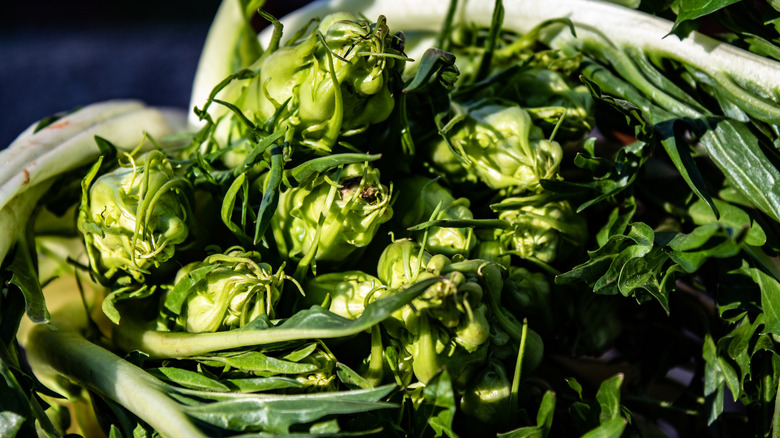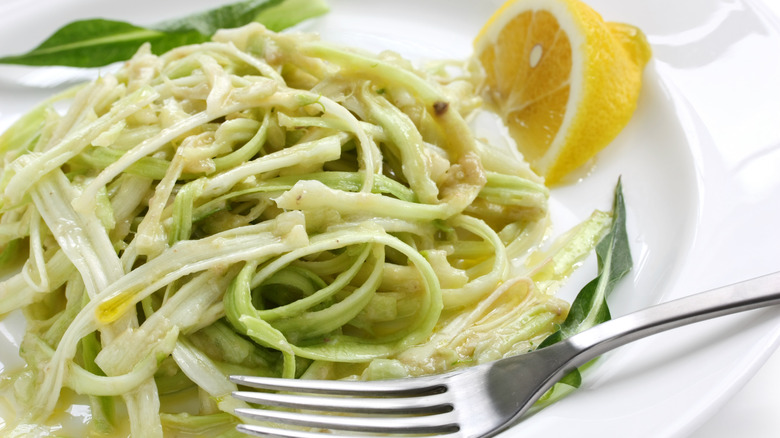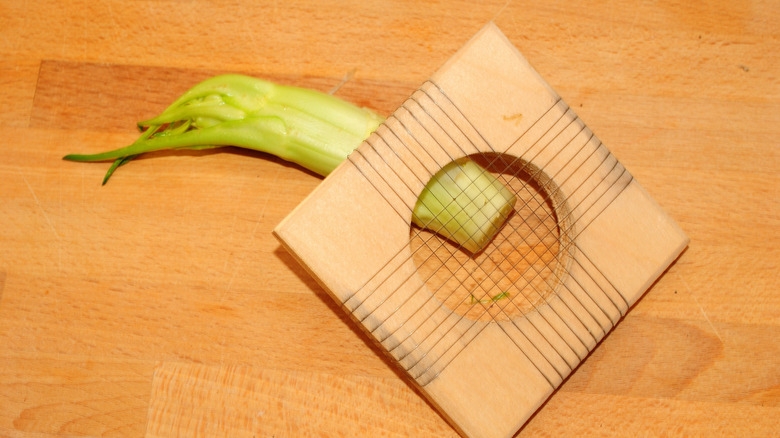What Is Puntarelle And How Is It Prepared?
Puntarelle is ubiquitous and wildly popular in Italy — especially in Rome — as well as in certain Italian-Americans regions and restaurants, but in general, it's hardly recognized in the US, which is a shame, because it is so very tasty!
Most frequently dressed with a mixture of olive oil, vinegar (usually either balsamic or red wine), garlic, and anchovy, the crispy curly puntarelle looks almost like a vegetal curly fry. It's a much sturdier salad green than lettuce or arugula, with a slight bite and a lot of crunch, and it's a true point of pride throughout Rome. It has some snap, and is an excellent complement vehicle for the umami-laden dressing.
Food52 notes that puntarelle is actually the name for the "inner stalks of Catalonian chicory." Rachel Eats states that is a "loose-leafed variety of chicory" and its stalks and shoots are very similar in appearance to dandelion greens. The chicory itself is a tightly-compacted bulb, but it conceals a delicious surprise. Once the outer stalks and leaves are removed, stalks or hearts lurk underneath. They look almost like small, ribbed celery. Puntarelle means "little points," a reference to the tender stalks hidden within the vegetable, but it also goes by catalogna di galatina, ciorcia di catalogna, or cicoria asparago (via Lucas Italy).
What is puntarella alla romana?
Puntarelle is primarily used in the cherished salad puntarella alla romana. It is not a mild flavored salad — it is piquant, assertive, and super flavorful. First, the chicory needs to be trimmed. It's important to distinguish, because the outer stalks tend to be essentially inedible because of their strong bitterness. However, the outer leaves are delicious and are often sautéed.
The puntarelle stalks themselves can be snapped off before being cut or thinly sliced prior to making the salad. Many Italians use a specific tool called a taglia puntarella in order to finely cut the stalks prior to making the cherished salad, but of course, you can also prepare the puntarelle using a sharp knife. The prepared puntarelle is also sold in markets throughout Rome.
Once prepared and cut, the puntarelle must sit in an ice bath to curl properly. The sauce or dressing, comprised of olive oil, vinegar, garlic, and anchovy, is traditionally made in a mortar.
How else can you cook puntarelle?
Tried and Supplied notes that puntarelle "tastes like a mix of dandelion, rocket, and licorice-scented fennel." It is primarily in season throughout the winter. While the inherent bitter notes are somewhat comparable to endive or radicchio, the flavor of puntarelle is really unique unto itself.
Dried fruits, soft cheeses, and even cured meats are excellent complements, because they help to temper the astringent notes of the puntarelle. Sharper flavors such as olives, capers, or tinned fish are other common pairings, because they help to bolster the flavor even further. Puntarelle can be enjoyed in an endless variety of salads.
While it is excellent raw, its sharp flavor is mellowed when its cooked. It's excellent sautéed, cooked with pasta, served with eggs, or even braised. These preparations also help to further offset the vegetable's punchy bitterness. Furthermore, puntarelle is a hearty, bitter green, so it also boasts many health benefits: Organic Authority notes that it's especially high in iron, vitamin A, and vitamin C.
If you are lucky enough to find some, we implore you to give it a try. The delectable and subtly bitter vegetable is underused in the states, and it's about time that that changes.


